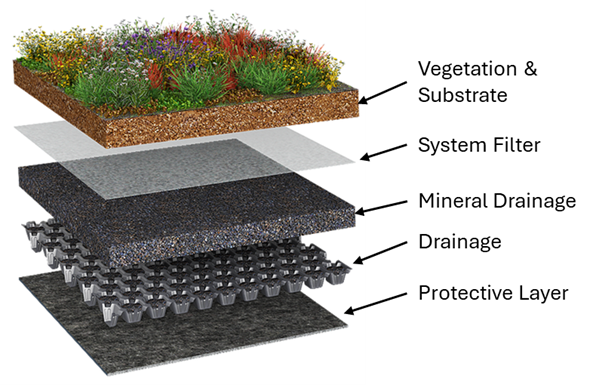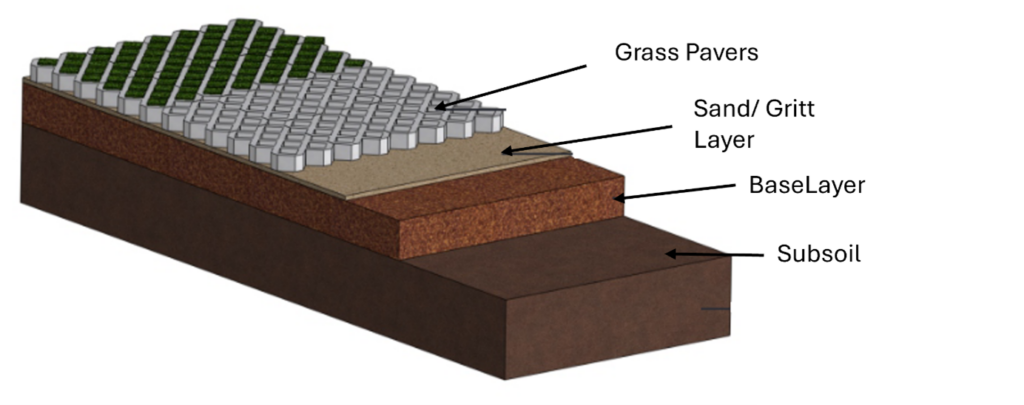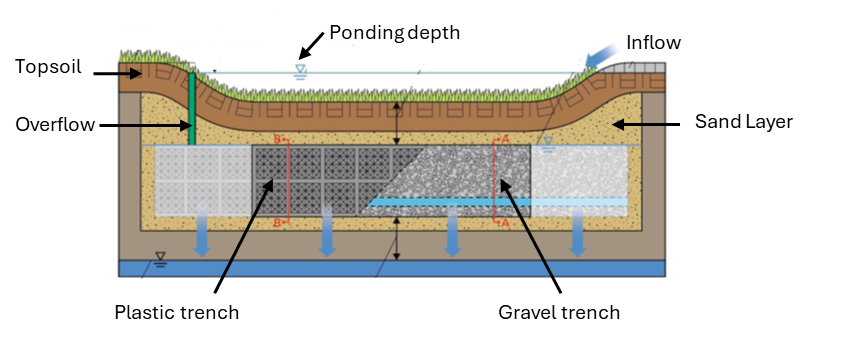Sustainable Urban Drainage Systems
Increasing urbanization and thus the rising proportion of sealed surfaces has a negative impact on the water cycle. The greater the proportion of sealed or paved surfaces, the more water flows off the surface and is discharged into the sewer network and the less water can seep into the ground and evaporate into the environment (Guo et. al., 2019; Maniak, 2016).
The approach of sustainable rainwater management, referred to here as SUDS (Sustainable Urban Drainage Systems), promotes an improvement in the urban water cycle. The aim of SUDS measures is to bring the urban water cycle closer to the natural, pre-development state. This is accompanied by measures to improve the climatic balance. With SUDS, precipitation water is temporarily stored and returned to the natural water cycle through infiltration or evapotranspiration (Wang, 2020).
This concept is implemented by combining various measures and elements at different scales (property, neighborhood, city, catchment area). The aim is retention, storage, evapotranspiration, infiltration, unsealing, decoupling and utilization of precipitation water. In most cases, the various elements are integrated into the environment as landscaped (park) facilities with integrated retention areas that are connected to waterways or drainage systems (Fletscher et. al., 2015).
Within the scope of the project, the implementation is only carried out for selected SUDS: green or retention roofs, swale-trench elements and permeable paving.
Green (or retention) roofs
Green or retention roofs are an evaporation-capable, near-natural alternative to conventional roofs. The vegetation layer forms the top layer, followed by the substrate, a system filter and then the drainage and protective layers. The difference between a retention roof and a green roof is that a retention roof has an additional mineral drainage layer underneath the substrate layer. This additional layer makes it possible to temporarily store more rainwater on the roof. This intermediate storage of precipitation means that a green roof can also be installed in warmer regions with less seasonal precipitation without the need for additional irrigation. Moreover, the greater availability of water makes it possible to increase evaporation locally (Rüngeler, 1998; City of Hanover, 2015). The schematic design of a retention roof is shown in Figure XX.

Permeable pavement
Permeable paving or grass pavers are a permeable and evaporation-capable alternative to conventional surface coverings or paving stones. The structure of grass pavers consists of several layers. First, a gravel or crushed stone base layer is applied to the substrate. A filter fleece is laid on top of this and then a fine-grained, permeable layer of sand or grit is applied as drainage. The top layer then consists of the grass pavers, into the joint spaces of which topsoil and turf are placed.

Depending on the structure, this alternative surface covering can bear low traffic loads and is therefore suitable for parking lots and low-traffic roads. For the sake of simplicity, all types of permeable paving are modeled/shown as grass pavers in the project. However, it is conceivable to use water-permeable asphalt on some areas. These are visually indistinguishable or hardly distinguishable from conventional asphalt but offer the possibility that some of the rainwater can seep away. However, when using these asphalts, it should be borne in mind that rainwater runoff from roads with heavy traffic is heavily contaminated (exhaust fumes, tire wear) and requires cleaning (Creabeton, 2014; bepco, 2024).
Swale-trench element
As the name suggests, swale-trench elements are a combination of an infiltration swale and a trench.
The infiltration swale is a permanent, vegetated depression in the ground (swale) of any shape. Swales are decentralized infiltration measures that temporarily store precipitation water on the surface. The precipitation or surface runoff is fed evenly into the swale via inlets at the edge of the swale. If a swale is particularly long or if there is a large slope, the swale must be interrupted with ground sills (DWA,2020).
Infiltration trenches are underground trench systems that are filled with either a plastic filling material or a natural weather-resistant material (coarse gravel or lava). The infiltration trench filling represents an additional underground storage volume in which precipitation can be temporarily stored and released into the subsoil with a delay. Depending on the infiltration trench’s filling material, the usable pore volume varies between 25 – 30% for coarse gravel and up to 90% for plastic. The inflow to a trench can either take place over the surface or underground through a perforated/permeable pipe (pipe-trench system) (DWA,2020; Sieker & Bandermann, 2020).
Swale trench elements are a combination of infiltration swales and trenches underneath. The element is usually fed via the swale, which releases the water into the additional “storage tank”, the infiltration trench. The layer between the swale and the infiltration trench is designed as a permeable sand layer to avoid long retention times of the swale. The infiltration into the subsoil then takes place through the infiltration trench (DWA2005).If the subsoil is less permeable, additional drainage of the infiltration trench into a pipe system is necessary. The infiltration trench is then connected to a shaft in which the runoff is throttled. If the various throttle drains of the individual infiltration trenches (with swales above them) are connected to each other, this is referred to as a swale-infiltration trench system (DWA2005).

References
…